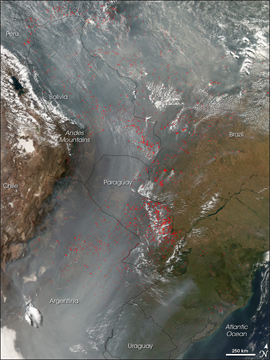Land-clearing fires send smoke across Argentina, Paraguay
Land-clearing fires send smoke across Argentina, Paraguay
mongabay.com
September 11, 2007
|
|
Thousands of fires likely set for land-clearing are sending thick smoke over southern South America, reports NASA.
Tuesday the space agency released satellite images that reveal fires burning across Brazil, Peru, Bolivia, Paraguay and Argentina.
NASA said that while naturally occurring fires are not uncommon in drier forests and grasslands in the region, the large number of fires are probably indicative of land-clearing by humans, likely for agriculture and cattle pasture. The agency noted that areas disturbed by logging, fragmentation, or previous burning were more vulnerable to fire.
“In these situations, planned fires (such as brush clearing fires on already cleared land) can easily get out of control and invade other areas, especially during drought years,” NASA said in a statement.
The fires span a range of ecosystems from the Amazon rainforest in Peru and Brazil to the open woodlands — known as the Chaco — in southern Bolivia, northwestern Paraguay and northern Argentina.
“Even in ecosystems where fires occur naturally (the Chaco, savannas, and grasslands), human activities may change the frequency and intensity of fires. The number and different kinds of plants and animals may change as a result,” explained NASA. “And in the Amazon, naturally occurring fire was historically very rare, and trees and other plants have no real adaptations to fire. Fires in the rainforest have the potential to completely transform the Southern Amazon forests into a savanna.”
NASA said that fires influence not only vegetation but also the atmosphere, noting that smoke has been shown to reduce cloudiness — therefore rainfall — over the Amazon but not near the ocean.
“The competing effects in different areas and weather conditions make it extremely challenging for scientists to say what the overall effect of smoke on clouds and rainfall is,” stated NASA.
This article is based on a news release from NASA.
